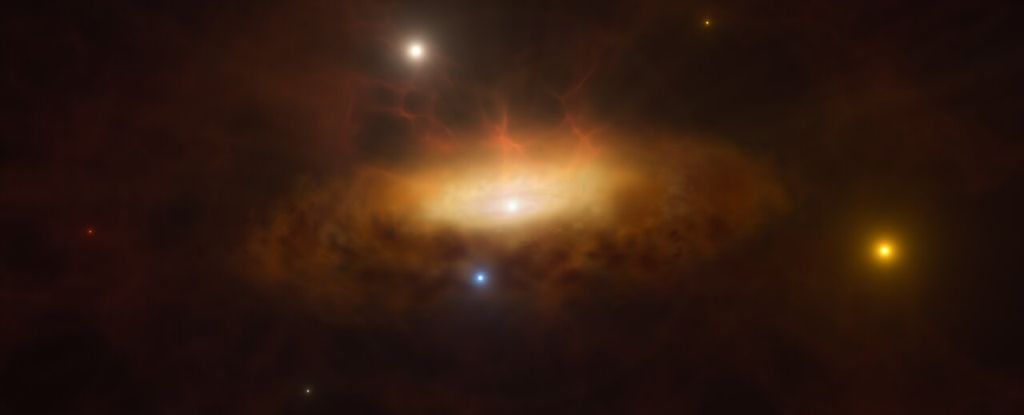In December 2019, astronomers were stunned when the core of a relatively sedate galaxy 300 million light-years away abruptly lit up like a Christmas tree, shining more brightly than we’ve ever seen it.
A giant black hole that kicked into gear and started guzzling material from the space around it is the best explanation for such a dim galaxy that suddenly blazes with light. Other events, like exploding stars, can cause a distant galaxy to brighten – but, typically, those events fade over time.
SDSS1335+0728, as the galaxy is known, did not do the typical thing. In fact, it has grown even brighter, shining in optical, infrared, and ultraviolet light to this day. More recently in February this year, it was even started to emit X-rays.
“The most tangible option to explain this phenomenon is that we are seeing how the [core] of the galaxy is beginning to show… activity,” says astronomer Lorena Hernández García of the Millennium Institute of Astrophysics (MAS) and the University of Valparaíso in Chile.
“If so, this would be the first time that we see the activation of a massive black hole in real time.”
Black holes don’t just sit in space constantly slurping. They can only access material that’s within their gravitational reach. If there’s nothing nearby, they remain relatively quiet, or quiescent. The supermassive black hole at the center of the Milky Way, for example, is not classified as active, since it’s only feeding minimally.
An active supermassive black hole, by contrast, is one that causes the space around it to light up. The black hole itself doesn’t shine, of course; but if there’s enough matter around it for a feeding frenzy, the forces at play, such as friction and gravity, cause the material to heat up to such an extreme that it blazes with light as it swirls inexorably towards the black hole.
Galaxies with varying levels of activity at their cores have been observed across the vast reaches of space-time, informing models that suggest the guzzling of great quantities of material is one of the mechanisms whereby supermassive black holes grow to such colossal sizes.
Evidence also suggests supermassive black holes can change up their activity levels. The Milky Way, for example, has giant bubbles extending above and below the galactic plane from previous activity in the center. Other galaxies have similar features.
But to see the transition from a quiescent phase to an active one is very special indeed.
We’ve seen black holes suddenly blaze with light before; this is usually what is known as a tidal disruption event, in which a passing star or other glob of matter is snared by a lurking black hole, producing a flare of light as it is torn apart and devoured.
A comprehensive analysis of the change in light produced by SDSS1335+0728 and its 1.5 million solar mass black hole reveals that a tidal disruption event is not the most likely culprit; such events are also usually short-lived.
frameborder=”0″ allow=”accelerometer; autoplay; clipboard-write; encrypted-media; gyroscope; picture-in-picture; web-share” referrerpolicy=”strict-origin-when-cross-origin” allowfullscreen>
“In the case of SDSS1335+0728,” says astronomer Claudio Ricci of the Diego Portales University in Chile, “we were able to observe the awakening of the massive black hole, [which] suddenly started to feast on gas available in its surroundings, becoming very bright.”
Astronomers have spotted other examples more recently of what may be a supermassive black hole entering an active phase, but further observations are required to determine whether the increase in brightness is ongoing.
This means SDSS1335+0728 could represent a blueprint for what such a transition looks like. Since we don’t know what triggers a supermassive black hole to switch on again, studying the galaxy could help astronomers develop models.
This, in turn, could reveal the likelihood of it occurring elsewhere – including right here in our own galaxy, the Milky Way.
It’s possible that SDSS1335+0728’s brightening could be the result of a very peculiar type of tidal disruption, however. Astronomers are going to continue to keep a close eye on it, to confirm what it is doing, and what this behavior could mean for our understanding of the Universe.
The research has been published in Astronomy & Astrophysics.





